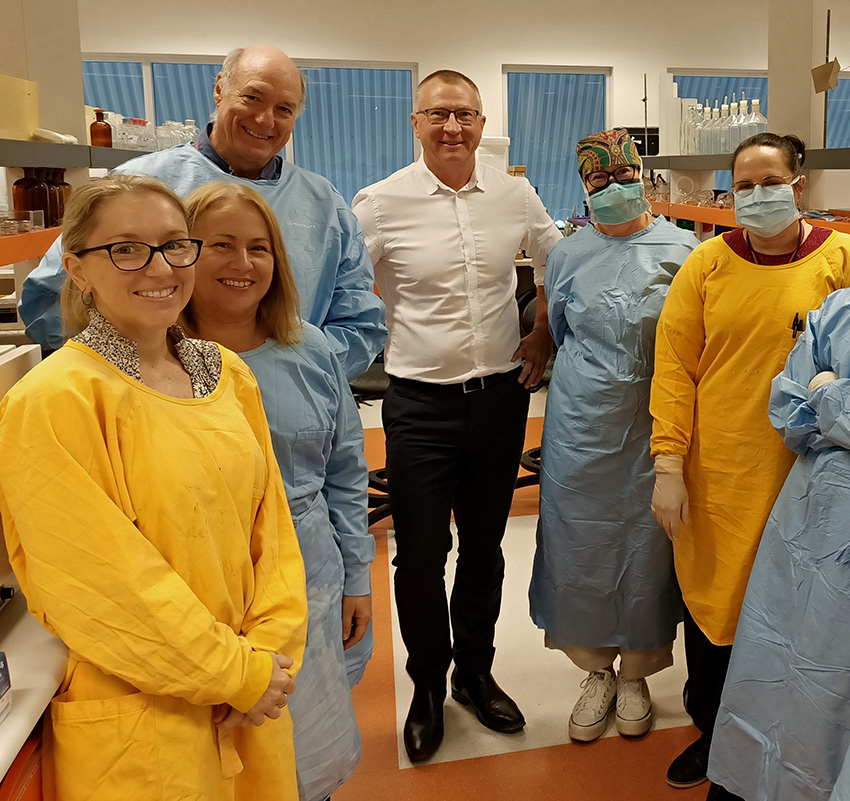Peer Reviewed Orthopaedic



Posted August 25, 2023
Geoffrey P. Dobson, Ph.D., Hayley Letson, Ph.D.,
Peter McEwen, MBBS FRACS, and Jodie Morris, Ph.D.,
James Cook University and Orthopaedic Research Institute of Queensland
A loud pop in the knee followed by severe pain is indicative of anterior cruciate ligament (ACL) injury. The ACL is a short band of connective tissue that joins the thigh bone to the shin bone, provides support to the joint, and is the most injured ligament in the knee.1 Due to the nature of military service, active-duty personnel are 10 times more likely than the civilian population to experience an ACL tear.2 Following injury to the knee, the joint experiences molecular chaos leading to an environment with increased inflammation and fibrosis, which can lead to scarring. Surgery is necessary to repair an ACL tear, but the trauma of surgery, increased inflammation, and fibrosis during and post-operation can lead to the early stages of post-traumatic osteoarthritis (PTOA), a form of arthritis that can develop due to joint injury. Among active-duty Service Members who experience ACL tear, more than half will not return to duty, and 50% will develop PTOA within 20 years of injury.2, 3 Because of its high prevalence, contribution to decreased military readiness, and long-term impact on quality of life, ACL tears present an urgent concern for identifying measures to improve surgical outcomes.
 Professor Geoffrey Dobson's research team at James Cook University and Orthopaedic Research Institute of Queensland, Australia.
Professor Geoffrey Dobson's research team at James Cook University and Orthopaedic Research Institute of Queensland, Australia. A combination therapy of adenosine, lidocaine, and magnesium (commonly referred to collectively as ALM) has been shown to decrease inflammation and fibrosis in a rat model of a total knee replacement. With a fiscal year 2019 Peer Reviewed Orthopaedic Research Program Applied Research Award, Dr. Geoffrey Dobson and his team sought to assess the utility of ALM in ACL reconstruction. In a military-relevant rat model of ACL rupture, the group investigated the effect of ALM on inflammation, immune system activation (a driver of fibrosis), and tissue repair within the knee joint. Experimentation began with inducing an ACL injury in the rats; at 3 days post-injury, the animals were divided into three groups: one group undergoing surgery while receiving ALM, another undergoing surgery and receiving a saline control, and a third group that did not receive surgical intervention or ALM treatment. Metrics such as concentrations of molecules that mediate inflammatory response and profiling of immune cells were assessed prior to surgery and at several time points
Interestingly, results indicated there were sex-specific differences when comparing inflammatory and immune responses, as well as healing characteristics within the knee joint between male and female rats. In males without surgical intervention, decreased healing response in the joint was observed compared to females. Similar results were observed in animals receiving ACL reconstruction surgery; in particular, proteins that promote inflammatory response peaked later and were more abundant in females than in males. During assessment of the effect of ALM post-ACL reconstruction, the inflammatory and immune response decreased overall in both sexes. However, sex-specific differences were observed in inflammatory response molecules, immune system components, and healing characteristics of the joint tissue at each time point.
The findings from Dr. Dobson and his team indicate that sex-specific differences exist in the knee-joint environment after injury and post-surgery that may lead to differences in healing. Additionally, ALM therapy has differential effects on inflammation, the immune system, and healing characteristics of the joint when comparing sexes in rats. This study identifies several potential targets of inflammation and the immune system that could be targeted to leverage sex-specific differences, as well as it suggests that a personalized approach of post-surgery therapy may have the potential to improve surgical outcomes and result in improved return to duty for Service Members.
References:
1 Evans J and Nielson JL. 2022. Anterior cruciate ligament knee injury. StatPearls. https://www.statpearls.com/point-of-care/23925
2 Tennent DH and Posner MA. 2019. The military ACL. The Journal of Knee Surgery. 32(2):118-122. https://doi.org/10.1055/s-0038-1676565
3 Rodriguez MJ, Garcia EJ, and Dickens JF. 2019. Primary and posttraumatic knee osteoarthritis in the military. The Journal of Knee Surgery 32(2):134-137. https://doi.org/10.1055/s-0038-1676956
Last updated Wednesday, March 12, 2025














